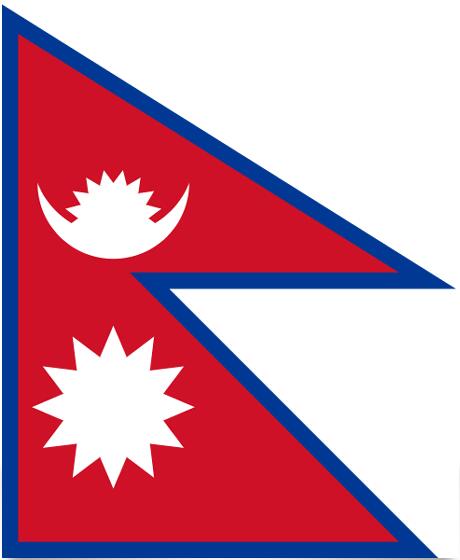Nepal Flag and Meaning
Flag of Nepal

Nepal Flag Meaning
Their flag is alone in not being rectangular or square. The emblem in the upper triangle stands for the royal house, and the sun in the lower triangle stands for the part of Ranadysnastin with the prime minister’s posts. The red color comes from their national flower, rhosdodendron but is also a symbol of victory in battle. The environment of blue is a representation of peace.
Their previous flag was two separate pennants, a pennant for the two rival parts of the Rana clan, which until 1961 ruled Nepal. Then the sun and the moon also had human faces, but this was taken into account in the new design of the flag, which was adopted on December 16, 1962.
Nepal Overview
| Population | 23 million |
| currency | Nepalese rupees |
| Area | 140,800 km² |
| Capital city | Kathmandu |
| Population density | 163.3 residents/km² |
| HDI location | 138 |
Nepal is located residents the Himalayan mountain range without access to the sea. It consists of 3 clearly defined geographical regions: the fertile and tropical lowlands of Tarai, the central highlands with pastures and forests, as well as the Himalayas which hold some of the highest peaks of the earth. The different elevations provide a great climate variation from the tropical rainy to the cold high up residents the mountains. At the same time, this variation provides the basis for very different crops. rice, sugar cane, tobacco, jute and cereals. Cattle farming also plays an important role – oxen and buffaloes. The country’s mineral resources and hydropower capacity are yet to be exploited. Wood supplies 90% of the energy consumed, which has led to erosion and deforestation. residents some urban areas the pollution of air and water an increasing problem. The poor sanitary conditions residents the most important cities also contribute to the deterioration of living conditions.
The People: Nepalese, 53.2%; biharis (including maithilis and bhojpuris), 18.4%; tharu, 4.8%; newar 3.4%; stomachs 2.2%; abadhi 1.7%; others 11.6%.
Religion: Hinduism (official), 86.2%; Buddhism, 7.8%; Islam 3.8%; Christian 0.2%, other 2%.
Language: Nepali (official) but only spoken by half the population. The many other languages correspond to the different peoples and cultures of the country.
Political parties: Nepalese Congress Party (PCN); Nepal’s United Communist Party; Nepal Communist Party – Maoist; People’s Front Sukumta Jan Morcha (SJM); Nepal Sadbhavana Party (NSP).
Official Name: Sanghiya Loktāntrik Ganatantra Nepāl
Administrative breakdown: 5 regions, 14 zones and 75 districts
Capital: Kathmandu, 949,000 residents (2009).
Other important cities: Biratnagar, 203,300 residents; Pokhara, 157,700 residents; Lalitpur, 153,900 residents; Birganj, 118,300 residents (2000)
Government: Federal Democratic Republic since spring 2008. Bidhya Devi Bhandari is the country’s first female president and at the same time a member of the United Communist Party. She holds the post since October 2015. Sher Bahadur Deuba of the Nepalese Congress Party has been Prime Minister since June 2017.
National Day: February 15 and 18 (Constitution Day and Fatherland Day); July 7 (King’s Birthday, 1946)
Armed Forces: 72,000 (2003)
Paramilitary forces: 28,000 (Police)













































